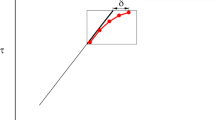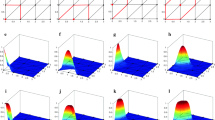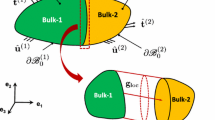Abstract
A computationally robust framework for simulating geomaterial failure patterns is presented in this paper. Finite element simulations which feature the use of embedded discontinuities to track material failure are known to suffer from convergence issues due to a lack of robustness. Oftentimes, complex time step-cutting schemes or arc-length methods are required in order to achieve convergence. This may invariably limit the complexity of constitutive models available for use in tracking nonlinear material behavior. To this end, we use an implicit–explicit integration scheme [Impl–Ex (Oliver et al. in Comput Methods Appl Mech Eng 195(52):7093–7114, 2006)] coupled with a novel constitutive model which allows for combined opening and shearing displacement in tension, as well as frictional sliding in compression. We show that this framework is suitable for capturing complex fracture patterns in geomaterial structures without the need for elaborate continuance schemes.



























Similar content being viewed by others
References
Alfaiate J, Wells GN, Sluys LJ (2002) On the use of embedded discontinuity elements with crack path continuity for mode-I and mixed-mode fracture. Eng Fract Mech 69(6):661–686
Ayatollahi MR, Sistaninia M (2011) Mode II fracture study of rocks using Brazilian disk specimens. Int J Rock Mech Min Sci 48(5):819–826
Belytschko T, Fish J, Engelmann BE (1988) A finite element with embedded localization zones. Comput Methods Appl Mech Eng 70(1):59–89
Blanco S, Goicolea JM, Polindara C (2012) A robust numerical framework for the analysis of material failure of fiber reinforced soft tissue. J Biomech 45(Supplement 1):S28
Borja RI (2000) A finite element model for strain localization analysis of strongly discontinuous fields based on standard galerkin approximation. Comput Methods Appl Mech Eng 190(11):1529–1549
Borja RI, Foster CD (2007) Continuum mathematical modeling of slip weakening in geological systems. J Geophys Res Solid Earth 112(B4):B04301-1–B04301-12
Borja RI, Regueiro RA (2001) Strain localization in frictional materials exhibiting displacement jumps. Comput Methods Appl Mech Eng 190(20–21):2555–2580
Camacho GT, Ortiz M (1996) Computational modelling of impact damage in brittle materials. Int J Solids Struct 33(20–22):2899–2938
Cornelissen HAW, Hordijk DA, Reinhardt HW (1986) Experimental determination of crack softening characteristics of normalweight and lightweight concrete. Heron 31(2):45–56
de Borst R, Remmers JJC, Needleman A (2006) Mesh-independent discrete numerical representations of cohesive-zone models. Eng Fract Mech 73(2):160–177
Dieterich HJ, Linker MF (1992) Fault stability under conditions of variable normal stress. Geophys Res Lett 19(16):1691–1694
Foster CD, Borja RI, Regueiro RA (2007) Embedded strong discontinuity finite elements for fractured geomaterials with variable friction. Int J Numer Methods Eng 72(5):549–581
Foster CD, Regueiro RA, Fossum AF, Borja RI (2005) Implicit numerical integration of a three-invariant, isotropic/kinematic hardening cap plasticity model for geomaterials. Comput Methods Appl Mech Eng 194(50–52):5109–5138
Guinea GV, Planas J, Elices M (1994) A general bilinear fit for the softening curve of concrete. Mater Struct 27(2):99–105
Hill R (1962) Acceleration waves in solids. J Mech Phys Solids 10(1):1–16
Hillerborg A, Modéer M, Petersson P-E (1976) Analysis of crack formation and crack growth in concrete by means of fracture mechanics and finite elements. Cem Concr Res 6(6):773–781
Huespe AE, Oliver J, Mora DF (2013) Computational modeling of high performance steel fiber reinforced concrete using a micromorphic approach. Comput Mech 52(6):1243–1264
Ida Y (1972) Cohesive force across the tip of a longitudinal-shear crack and Griffith’s specific surface energy. J Geophys Res 77(20):3796–3805
Jirásek M (2000) Comparative study on finite elements with embedded discontinuities. Comput Methods Appl Mech Eng 188(1–3):307–330
Jirásek M, Belytschko T (2002) Computational resolution of strong discontinuities. In: Proceedings of fifth world congress on computational mechanics, WCCM V, Vienna University of Technology, Austria
Mair K, Abe S (2011) Breaking up: comminution mechanisms in sheared simulated fault gouge. Pure Appl Geophys 168(12):2277–2288
Oliver J, Diaz G, Manzoli OL, Huespe AE (2008) Three-dimensional analysis of reinforced concrete members via embedded discontinuity finite elements. Revista IBRACON de Estruturas e Materiais 1:58–83 03
Mosler J, Meschke G (2003) 3D modelling of strong discontinuities in elastoplastic solids: fixed and rotating localization formulations. Int J Numer Methods Eng 57(11):1553–1576
Motamedi MH, Foster CD (2015) An improved implicit numerical integration of a non-associated, three-invariant cap plasticity model with mixed isotropic–kinematic hardening for geomaterials. Int J Numer Anal Methods Geomech 39(17):1853–1883
Oliver J (2000) On the discrete constitutive models induced by strong discontinuity kinematics and continuum constitutive equations. Int J Solids Struct 37(48–50):7207–7229
Oliver J, Huespe AE, Samaniego E (2003) A study on finite elements for capturing strong discontinuities. Int J Numer Methods Eng 56(14):2135–2161
Oliver J, Huespe AE (2004) Theoretical and computational issues in modelling material failure in strong discontinuity scenarios. Comput Methods Appl Mech Eng 193(27–29):2987–3014
Oliver J, Huespe AE, Blanco S, Linero DL (2006) Stability and robustness issues in numerical modeling of material failure with the strong discontinuity approach. Comput Methods Appl Mech Eng 195(52):7093–7114
Oliver J, Huespe AE, Blanco S, Linero DL (2007) Evolving material discontinuities: numerical modeling by the continuum strong discontinuity approach (CSDA). In: Combescure A, De Ren B, Belytschko T (eds) IUTAM symposium on discretization methods for evolving discontinuities. IUTAM bookseries, vol 5. Springer, Berlin, pp 123–138
Oliver J, Huespe AE, Cante JC (2008) An implicit/explicit integration scheme to increase computability of non-linear material and contact/friction problems. Comput Methods Appl Mech Eng 197(21–24):1865–1889
Oliver J, Linero DL, Huespe AE, Manzoli OL (2008) Two-dimensional modeling of material failure in reinforced concrete by means of a continuum strong discontinuity approach. Comput Methods Appl Mech Eng 197(5):332–348
Ortiz M, Leroy Y, Needleman A (1987) A finite element method for localized failure analysis. Comput Methods Appl Mech Eng 61(2):189–214
Bitencourt LAG, Bittencourt T Jr, Prazeres PGC, Manzoli OL (2015) A modified implicit–explicit integration scheme: an application to elastoplasticity problems. J Braz Soc Mech Sci Eng 38:151–161
Futai MM, Bittencourt T, Manzoli OL, Prazeres PGC (2015) Use of the impl-ex integration scheme to simulate sequential excavation with the finite element method. In: Proceedings of the World Tunnel Congress 2014—Tunnels for a better Life. Foz do Iguau, Brazil
Regueiro RA, Foster CD (2011) Bifurcation analysis for a rate-sensitive, non-associative, three-invariant, isotropic/kinematic hardening cap plasticity model for geomaterials: Part i. small strain. Int J Numer Anal Methods Geomech 35(2):201–225
Regueiro RA, Borja RI (1999) A finite element model of localized deformation in frictional materials taking a strong discontinuity approach. Finite Elem Anal Des 33(4):283–315
Regueiro RA, Borja RI (2001) Plane strain finite element analysis of pressure sensitive plasticity with strong discontinuity. Int J Solids Struct 38(21):3647–3672
Reinhardt H (1984) Fracture mechanics of fictitious crack propagation in concrete. Heron 29(2):3–42
Rinehart AJ, Bishop JE, Dewers T (2015) Fracture propagation in Indiana limestone interpreted via linear softening cohesive fracture model. J Geophys Res Solid Earth 120(4):2292–2308
Rudnicki JW, Rice JR (1975) Conditions for the localization of deformation in pressure-sensitive dilatant materials. J Mech Phys Solids 23(6):371–394
Sanchez PJ, Huespe AE, Oliver J (2008) On some topics for the numerical simulation of ductile fracture. Int J Plast 24(6):1008–1038
Simo JC, Oliver J, Armero F (1993) An analysis of strong discontinuities induced by strain-softening in rate-independent inelastic solids. Comput Mech 12(5):277–296
Simo JC, Rifai MS (1990) A class of mixed assumed strain methods and the method of incompatible modes. Int J Numer Methods Eng 29(8):1595–1638
Sluys LJ, Berends AH (1998) Discontinuous failure analysis for mode-I and mode-II localization problems. Int J Solids Struct 35(31–32):4257–4274
Tresca MH (1878) On further applications of the flow of solids. J Frankl Inst 106(5):326–334
Wells GN, Sluys LJ (2000) Application of embedded discontinuities for softening solids. Eng Fract Mech 65(2–3):263–281
Wu T, Wriggers P (2015) Multiscale diffusion–thermal–mechanical cohesive zone model for concrete. Comput Mech 55:999–1016
Yang Z, Frank XX (2008) A heterogeneous cohesive model for quasi-brittle materials considering spatially varying random fracture properties. Comput Methods Appl Mech Eng 197(45–48):4027–4039
Yin A, Yang X, Gao H, Zhu H (2012) Tensile fracture simulation of random heterogeneous asphalt mixture with cohesive crack model. Eng Fract Mech 92:40–55
Acknowledgments
The authors would like to acknowledge the support of the National Science Foundation, Grant No. NSF-CMMI 1030398.
Author information
Authors and Affiliations
Corresponding author
Appendices
Appendix 1: Slip algorithms for both newly localized band and preexisting slip on band
Appendix 2: Derivatives of the yield functions
The gradients of the yield functions are as follows:
where
To determine the derivatives of the bulk stresses with respect to the jumps, recall
Hence,
and therefore
Appendix 3: Derivation of the effective algorithmic operator
The effective algorithmic operator is defined as
by taking the derivative of the semi-implicit stress in Eq. (6.15) with respect to the implicit strain, we have the following:
where
Noting that \({\varvec{c}}^{e}:\frac{\partial {\varvec{\epsilon }}_{n+1}}{\partial {\varvec{\epsilon }}_{n+1}} = {\varvec{c}}^{e}:{\varvec{I}}= {\varvec{c}}^{e}\), we group terms and factor:
finally
The calculation in Eq. 11.4 is possible only if the quantities are in matrix form, and hence, the fourth-order symmetric identity tensor, \({\varvec{I}}\), must be written as the identity matrix given by
and additionally, \({\varvec{c}}^{e}\) and \(\tilde{{\varvec{A}}}_{n+1}\) should be written as \(6 \times 6\) matrices. After the quantities are multiplied, the result can be reduced to a \(3 \times 3\) matrix which is suitable for the case of plane strain.
Rights and permissions
About this article
Cite this article
Weed, D.A., Foster, C.D. & Motamedi, M.H. A robust numerical framework for simulating localized failure and fracture propagation in frictional materials. Acta Geotech. 12, 253–275 (2017). https://doi.org/10.1007/s11440-016-0474-4
Received:
Accepted:
Published:
Issue Date:
DOI: https://doi.org/10.1007/s11440-016-0474-4




